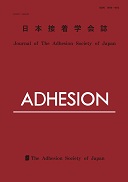
- |<
- <
- 1
- >
- >|
-
Mayumi HATAKEYAMA, Takuya KITAOKA2020 Volume 56 Issue 2 Pages 57-62
Published: February 01, 2020
Released on J-STAGE: September 30, 2021
JOURNAL FREE ACCESSCarbohydrate chains are the third biopolymer following nucleic acids and proteins. Cells are covered with chain-like carbohydrates derived from glycoproteins and glycolipids. Cellular signaling and regulation in biological systems occur on the boundary surfaces of cell membranes, called biointerfaces here, via carbohydrate-protein interactions. Therefore, structural and biofunctional design of carbohydrate-based scaffolds for cell culture applications has attracted much attention in tissue engineering and regenerative medicines. However, in most cases, such trials remain limited to utilize the physicochemical properties of polysaccharides such as porous gel structures and water uptake properties. In our works, various carbohydrate chains were site-selectively modified at their reducing ends with thiosemicarbazide, and successfully immobilized on a gold substrate through self-assembly chemisorption via S-Au bonding. Carbohydrate clusters with regulated orientation and surface density made significant contribution to cell adhesion, cellular signaling and alignment required for tissue engineering. Besides, the rigid nanofibrous form of surface-carboxylated cellulose nanofibers was promising to imitate the structures and functions of extracellular matrix in vivo from viewpoints of physics and chemistry. This article focuses on the in vitro carbohydrate-mediated bioresponses in cell culture systems, and reviews our recent advances in the functional nano-architectonics of glyco-biointerfaces to realize materials therapy.
View full abstractDownload PDF (3466K)
-
Yoshiaki URAHAMA, Junpei MURATA, Hajime KISHI2020 Volume 56 Issue 2 Pages 48-56
Published: February 01, 2020
Released on J-STAGE: September 30, 2021
JOURNAL RESTRICTED ACCESSCrosslink dependence of molecular weight distribution of sol fraction of lightly-crosslinked butyl acrylate - acrylic acid copolymers were studied. The butyl acrylate / acrylic acid( 95 / 5 in weight) copolymers were synthesized using living radical polymerization. In the sol fraction of the low equivalent composition( ie. 0.001 eq. and 0.002 eq.) of the crosslinking agent, the fraction of the molecular weight distribution of 1,000,000 or more was increased. Simultaneously, the distribution in the low molecular weight region was reduced. Moreover, the molecular weight distribution of the sol fraction was assumed to be sum of 3 curves of normal( Gauss) distribution, then was quantitatively analyzed using multi-peak fitting method. As the results, next conclusions were clarified: 1. Dimerization occurred without gelation in the low equivalent composition, which made the fraction of the molecular weight distribution of 1,000,000 or more. 2. With increasing the cross-linking agent, the high molecular weight fraction was sequentially altered into gel fraction. Therefore, the high molecular weight distribution of the sol fraction rapidly decreased with increasing the gel formation.
View full abstractDownload PDF (1915K)
-
Keiji TANAKAArticle type: research-article
2020 Volume 56 Issue 2 Pages 42-47
Published: February 01, 2020
Released on J-STAGE: September 30, 2021
JOURNAL FREE ACCESSAdhesion technology has been used not only for devices and mobility, but also for social infrastructure, and becoming the basic technology for next-generation manufacturing. While the research and development for producing high-performance adhesives have widely progressed, understanding of the adhesion phenomenon at the molecular level has not achieved yet. That is, the systematic research on the elucidation of the principle of the adhesion mechanism has not been conducted. We here show aggregation states and dynamics of polymer chains, as a model of adhesive molecules, at the interfacial region with a solid using mainly modern interfacial sensitive spectroscopy.
View full abstractDownload PDF (2147K)
- |<
- <
- 1
- >
- >|